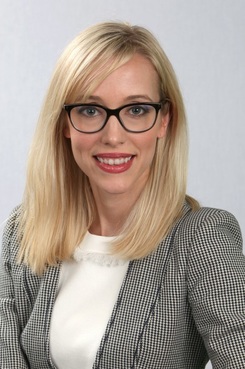Ruling the Rainmaking Roost: Six Tips to Help You Get There
To grow as a lawyer, most of us need to learn—at some point—how to “make it rain.” Rainmaking, as I define it, simply means building and bringing in work. The kind of work that is being built, and the sources of that work, mean different things to different kinds of lawyers.
October 18, 2018 at 12:03 PM
7 minute read
 Jennifer Betts, Ogletree, Deakins, Nash, Smoak & Stewart
Jennifer Betts, Ogletree, Deakins, Nash, Smoak & Stewart
To grow as a lawyer, most of us need to learn—at some point—how to “make it rain.” Rainmaking, as I define it, simply means building and bringing in work. The kind of work that is being built, and the sources of that work, mean different things to different kinds of lawyers.
For some tips on how to succeed in the rainmaking game, this article consolidates recommendations from a number of female attorneys in different phases of their careers and working in different environments.
Be Involved
Christine Elzer, principal at Elzer Law Firm in Pittsburgh, who represents individual plaintiffs, says that, for her, the best source of work is through referrals. To become a go-to referral recipient, Elzer has become highly involved in both the Pittsburgh legal and social communities. She has joined professional organizations (and even committees within those organizations), attends various social events, and volunteers regularly to present at continuing legal education seminars.
Becoming involved in the local community is easy advice to give, but often hard to put into action particularly for those among us who are not comfortable in social situations. Elzer, who describes herself as “someone who was never particularly outgoing and is as busy as any other attorney,” says that “these skills did not come so easily. It was a learning process, but it has been worthwhile.”
Be Yourself, And Try to Be Nice to Those You Encounter
As an attorney who has only worked on the defense side in large firms during my career, adversarial relationships with opposing counsel seemed inevitable. But my philosophy, which is consistent with my personality, has always been that you catch more flies with honey than with vinegar. I strive to build cordial, collegial relationships with everyone that I encounter, from the judges I am practicing in front of, the practice assistants working for my clients, the law clerks working with judges, to the attorneys on the opposite side of the “v.”
And, for me, it has paid off. In my career, I have been surprised to receive client referrals from plaintiffs counsel who I was adverse to years before. And I recently retained a new client from building a relationship with a client's assistant more than five years ago, who transitioned to a human resources role in an entirely separate company. As someone trying to build business, I have found that forming genuine relationships—with everyone—really does make a difference.
Elzer echoes this feedback. She recommends that, particularly for junior attorneys, being mindful of how you are perceived is critical: “Early in your career, it is important to make a good impression on attorneys from as many practice areas as possible, so that you become their go-to lawyer when asked for a referral. Only then can you successfully build a word-of-mouth business.”
Mariah McGrogan, an associate at Reed Smith, advises that her biggest tip to female attorneys as they look to expand their careers is to “be yourself and take things at a pace that you are comfortable with. Some people are blessed with the gift of gab, and have the ability to charm everyone they meet with seemingly little effort. Others, including myself, take longer to warm up. That doesn't make us any less likely to light the world on fire. Ours is just a slow burn.”
Be a Problem Solver
Sometimes clients are not outside your company or firm—they are your internal business partners (if you are in-house) or more senior attorneys (if you are at a firm). Just as much care and attention needs to be paid to satisfying these clients.
As a rising associate, McGrogan's focus is on internal rainmaking. She believes that “internal rainmaking is providing stellar customer service to the counsel and partners that assign me to their cases.” To build a foundation of trust, and a continuous flow of work, she makes efforts to communicate frequently with internal stakeholders about how cases and matters are developing.
Litigation being uncertain and full of risk, sometimes this means having tough conversations with internal clients about the fact that things have gone awry. This could be anything from a phase costing more than budgeted to first notice that an argument was lost. When that happens, McGrogan advises that bad news does not get better with age. She promptly notifies her internal client and comes prepared with solutions, explaining “I want them to view me as a problem solver, not a problem reporter. That way, even when a case might take a bad turn, it will hopefully reflect on the nature of the case—rather than my involvement in it.”
Be Knowledgeable About Your Client's Preferences
Every client has preferences. Some clients that I work with hate emails that contain more than one printed out page of content. Others hate phone calls and want lengthy email updates. I consider it my job to know each client's preferences and to try to keep the clients happy.
The head of litigation at an international retail company advises that her biggest pet peeves are ineffective communicators, attorneys who do not appreciate the number of priorities that must be juggled in the in-house lawyer role, and attorneys who do not try to understand the bigger picture with respect to the importance of a particular matter to an organization. When searching for outside counsel, this attorney ranks as most important the attorney's “personality and ability to communicate with all types of people,” noting that, “of course, I always want to work with lawyers who are well versed in substantive legal issues.” “But I also need to work with individuals who I like and respect (and feel mutual respect in return) and are effective communicators who are comfortable working with anyone—from an hourly employee to the CEO of the company.”
Be Web Savvy
Today, it can seem like if you aren't on the internet, you don't exist. External clients almost always go online to research the attorneys with whom they are considering working. If your biography and LinkedIn pages are out of date, stale, or not dynamic, you will stand out—and not in a positive way.
When Elzer was starting her own law firm, she invested heavily in her website and search engine optimization. Once established, she spends approximately an hour a week maintaining her web presence. I also attempt to devote at least an hour each week to sharing articles either I or my colleagues have written on LinkedIn, and staying up-to-date on what is going on with my contacts in their careers. Having a virtual presence, particularly for younger attorneys, will only grow in importance and making this a priority is wise.
Find Champions
No one does it alone. Rainmaking is often a slog, with investments of time, energy and effort paying off years and years down the road. It can be disheartening at times, and is a heavy burden to carry on top of performing legal work. To succeed, most of us need to build and grow internal and external champions who know us, like us, and are thrilled to tell the world how wonderful we are. I've learned over my career that many are thrilled to serve in that role—all it takes is a conversation to let them know that you would love help.
Jennifer G. Betts, a shareholder at Ogletree, Deakins, Nash, Smoak & Stewart, represents and counsels employers regarding complex traditional labor and employment matters. She has defended numerous employment class and collective actions for clients in a wide array of industries including retailers, manufacturers, banks, and in the energy sector.
This content has been archived. It is available through our partners, LexisNexis® and Bloomberg Law.
To view this content, please continue to their sites.
Not a Lexis Subscriber?
Subscribe Now
Not a Bloomberg Law Subscriber?
Subscribe Now
NOT FOR REPRINT
© 2025 ALM Global, LLC, All Rights Reserved. Request academic re-use from www.copyright.com. All other uses, submit a request to [email protected]. For more information visit Asset & Logo Licensing.
You Might Like
View All

From Courtroom to Cradle: Practical Advice for Young Attorneys About Parental Leave
7 minute read

Trending Stories
Who Got The Work
J. Brugh Lower of Gibbons has entered an appearance for industrial equipment supplier Devco Corporation in a pending trademark infringement lawsuit. The suit, accusing the defendant of selling knock-off Graco products, was filed Dec. 18 in New Jersey District Court by Rivkin Radler on behalf of Graco Inc. and Graco Minnesota. The case, assigned to U.S. District Judge Zahid N. Quraishi, is 3:24-cv-11294, Graco Inc. et al v. Devco Corporation.
Who Got The Work
Rebecca Maller-Stein and Kent A. Yalowitz of Arnold & Porter Kaye Scholer have entered their appearances for Hanaco Venture Capital and its executives, Lior Prosor and David Frankel, in a pending securities lawsuit. The action, filed on Dec. 24 in New York Southern District Court by Zell, Aron & Co. on behalf of Goldeneye Advisors, accuses the defendants of negligently and fraudulently managing the plaintiff's $1 million investment. The case, assigned to U.S. District Judge Vernon S. Broderick, is 1:24-cv-09918, Goldeneye Advisors, LLC v. Hanaco Venture Capital, Ltd. et al.
Who Got The Work
Attorneys from A&O Shearman has stepped in as defense counsel for Toronto-Dominion Bank and other defendants in a pending securities class action. The suit, filed Dec. 11 in New York Southern District Court by Bleichmar Fonti & Auld, accuses the defendants of concealing the bank's 'pervasive' deficiencies in regards to its compliance with the Bank Secrecy Act and the quality of its anti-money laundering controls. The case, assigned to U.S. District Judge Arun Subramanian, is 1:24-cv-09445, Gonzalez v. The Toronto-Dominion Bank et al.
Who Got The Work
Crown Castle International, a Pennsylvania company providing shared communications infrastructure, has turned to Luke D. Wolf of Gordon Rees Scully Mansukhani to fend off a pending breach-of-contract lawsuit. The court action, filed Nov. 25 in Michigan Eastern District Court by Hooper Hathaway PC on behalf of The Town Residences LLC, accuses Crown Castle of failing to transfer approximately $30,000 in utility payments from T-Mobile in breach of a roof-top lease and assignment agreement. The case, assigned to U.S. District Judge Susan K. Declercq, is 2:24-cv-13131, The Town Residences LLC v. T-Mobile US, Inc. et al.
Who Got The Work
Wilfred P. Coronato and Daniel M. Schwartz of McCarter & English have stepped in as defense counsel to Electrolux Home Products Inc. in a pending product liability lawsuit. The court action, filed Nov. 26 in New York Eastern District Court by Poulos Lopiccolo PC and Nagel Rice LLP on behalf of David Stern, alleges that the defendant's refrigerators’ drawers and shelving repeatedly break and fall apart within months after purchase. The case, assigned to U.S. District Judge Joan M. Azrack, is 2:24-cv-08204, Stern v. Electrolux Home Products, Inc.
Featured Firms
Law Offices of Gary Martin Hays & Associates, P.C.
(470) 294-1674
Law Offices of Mark E. Salomone
(857) 444-6468
Smith & Hassler
(713) 739-1250





